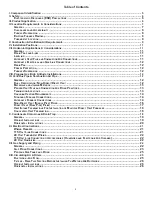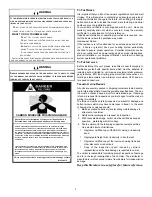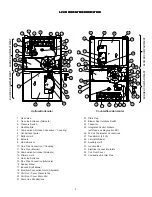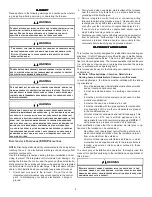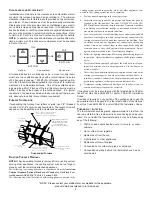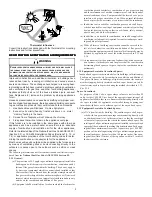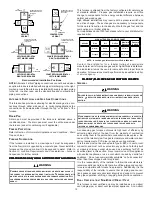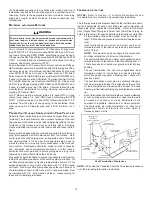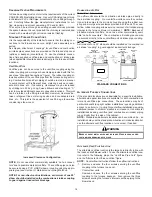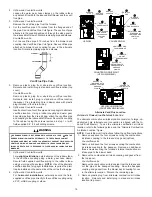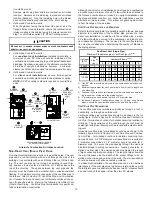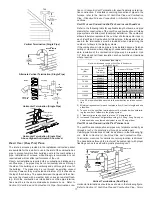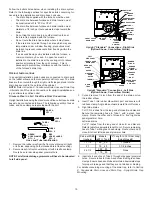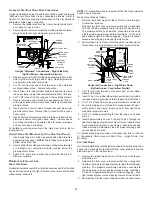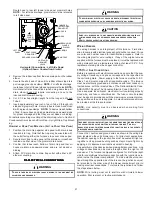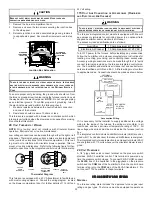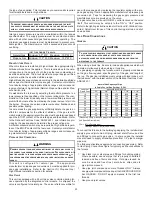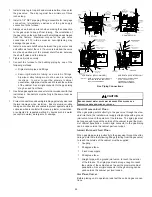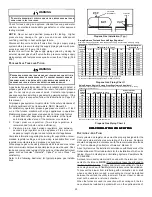
11
5. When directly communicating with the outdoors, the single open-
ing shall have a minimum free area of 1 square inch per 3,000
BTU per hour of total input rating of all equipment in the enclo-
sure.
5.3.4 Specially Engineered Installations:
The requirements of 5.3.3 shall not necessarily govern when special engi-
neering, approved by the authority having jurisdiction, provides an ad-
equate supply of air for combustion, ventilation, and dilution of flue
gases.
5.3.5 Louvers and Grilles:
In calculating free area in 5.3.3, consideration shall be given to the block-
ing effect of louvers, grilles or screens protecting openings. Screens
used shall not be smaller than 1/4 inch mesh. If the area through a
design of louver or grille is known, it should be used in calculating the
size of opening required to provide the free area specified. If the design
and free area is not known, it may be assumed that wood louvers will
have 20-25 percent free area and metal louvers and grilles will have 60-
75 percent free area. Louvers and grilles shall be fixed in the open
position or interlocked with the equipment so that they are opened au-
tomatically during equipment operation.
5.3.6 Special Conditions Created by Mechanical Exhausting or Fire-
places:
Operation of exhaust fans, ventilation systems, clothes dryers, or fireplaces
may create conditions requiring special attention to avoid unsatisfac-
tory operation of installed gas utilization equipment. Air from Inside
Building. See 5.3.3-a.
VI. INST
VI. INST
VI. INST
VI. INST
VI. INSTALL
ALL
ALL
ALL
ALLA
A
A
A
ATI
TI
TI
TI
TIO
O
O
O
ON POSITI
N POSITI
N POSITI
N POSITI
N POSITIO
O
O
O
ONS
NS
NS
NS
NS
This furnace may be installed in an upright position or horizontal on
either the left or right side panel. Do not install this furnace on its
back. For
upright upflow
furnaces, return air ductwork may be at-
tached to the side panel(s) and/or basepan. For
horizontal upflow
furnaces, return air ductwork must be attached to the basepan. For
both
upright or horizontal counterflow
furnaces, return ductwork must
be attached to the basepan (top end of the blower compartment).
NOTE:
Ductwork must never be attached to the back of the fur-
nace. Contact your distributor for proper airflow requirements and
number of required ductwork connections. Refer to “Recommended
Installation Positions” figure for appropriate installation positions,
ductwork connections, and resulting airflow arrangements.
VII. HO
VII. HO
VII. HO
VII. HO
VII. HORIZO
RIZO
RIZO
RIZO
RIZONT
NT
NT
NT
NTAL APPLI
AL APPLI
AL APPLI
AL APPLI
AL APPLIC
C
C
C
CA
A
A
A
ATI
TI
TI
TI
TIO
O
O
O
ONS & CO
NS & CO
NS & CO
NS & CO
NS & CONSID
NSID
NSID
NSID
NSIDERA
ERA
ERA
ERA
ERATI
TI
TI
TI
TIO
O
O
O
ONS
NS
NS
NS
NS
G
ENERAL
Horizontal applications, in particular, may dictate many of the
installation’s specifics such as airflow direction, ductwork connec-
tions, flue and combustion air pipe connections, etc. The basic ap-
plication of this furnace as a horizontal furnace differs only slightly
from an upright installation. When installing a furnace horizontally,
additional consideration must be given to the following:
ALTERNATE VENT/FLUE
AND COMBUSTION AIR
INTAKE LOCATIONS
FURNACE MUST BE LEVEL
FROM END TO END
FURNACE MUST BE LEVEL
OR SLIGHTLY TILTED FORWARD
WITH THE DOORS 0" - 3/4"
BELOW THE BACK PANEL
DRAIN LINE WITH 1/4" PER FOOT
DOWNWARD SLOPE
36" MINIMUM SERVICE
CLEARANCE REQUIRED
FURNACE MUST BE SUPPORTED
AT BOTH ENDS AND MIDDLE
DRAIN PAN
GAS LINE WITH
DRIP LEG (3" MINIMUM)
4 3/4" MINIMUM
DRAIN TRAP
CLEARANCE
Horizontal Furnace
D
RAIN
T
RAP
AND
L
INES
In horizontal applications the condensate drain trap is secured to
the furnace side panel, suspending it below the furnace. A mini-
mum clearance of 4 3/4 inches below the furnace must be provided
for the drain trap. Additionally, the appropriate downward piping
slope must be maintained from the drain trap to the drain location.
Refer to
Section X, Condensate Drain Trap and Lines
for further
details. If the drain trap and drain line will be exposed to tempera-
tures near or below freezing, adequate measures must be taken to
prevent condensate from freezing.
L
EVELING
Leveling ensures proper condensate drainage from the heat ex-
changer and induced draft blower. For proper flue pipe drainage,
the furnace must be level lengthwise from end to end. The furnace
should also be level from back to front or have a slight tilt with the
access doors downhill (approximately 3/4 inches) from the back
panel. The slight tilt allows the heat exchanger condensate, gener-
ated in the recuperator coil, to flow forward to the recuperator coil
front cover.
A
LTERNATE
V
ENT
/F
LUE
AND
C
OMBUSTION
A
IR
C
ONNECTIONS
In horizontal installations provisions for alternate flue and combus-
tion air piping are available for upflow furnaces with left discharge
and counterflow furnaces with right air discharge. This configura-
tion allows the flue and combustion air piping to be run vertically
through the furnace. Refer to the “Recommended Installation Posi-
tions” figure for further detail. The standard piping connections may
also be used in these positions. Refer to
Section IX, Vent/Flue Pipe
and Combustion Air Pipe for details concerning the conversion to
the alternate vent/flue and combustion air connections.


